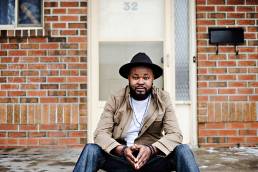Photo: Tamarack Drive, a series of images from 1969 taken by Roy Francis. Installed on the exterior of East Campus Hall at University of Waterloo Art Gallery. Photographer: Scott Lee.
Black creatives talk about the need for year round support of Black initiatives
Feb 8, 2022
By Glodeane Brown
February is recognized as Black History Month. Black History Month originated in America in 1926. Initially a weeklong initiative by historian Carter G. Woodson to promote the study and inclusion of Black History and celebrate the successes of African Americans, it became a month-long event in 1976. February is also Black Futures Month. Black Futures Month celebrates history while also looking ahead and envisioning collective Black liberation. This is the time of year when individuals and organizations “focus on Black voices and stories” and the inboxes of Black creatives and speakers start to fill with February specific requests. What about the other 11 months of the year? Black History, Black Futures, and Black people don’t just suddenly disappear between March 1st and January 31st. Black creativity happens year-round and there should be an ongoing investment in recognizing and supporting it beyond February. Ontario Culture Days spoke to three Black creatives about what they are working on and what Black Futures means to them.

Vanessa Spence, Artistic Director of Virtu Arts
Vanessa Spence is a theatre performer, playwright, producer, and arts educator. She is the Artistic Director of Virtu Arts, an emerging theatre company that develops the work and artistry of African, Caribbean, and Black diasporic artists and creators in regions outside of Toronto. She is also a Producer at Obsidian Theatre Company. Spence says it’s frustrating to only feel seen by larger organizations during Black History Month and says that there needs to be a conscious effort to spread the love for Black initiatives, businesses, and organizations throughout the year rather than concentrating on this one month. Virtu Arts as an organization won’t be hosting any events for BHM. This year they will be focussing on solidifying their programming for the months ahead to ensure they are being represented in the best light year-round. For years, Spence has felt chained to the notion that she and her organization have to present something to the community in February but in reality, found that the month was oversaturated with panels and exhibits on Black history. BHM events started to feel like they weren’t for her as a Black person, but to either guilt certain communities for their hand in her oppression or to try to educate those same communities about her existence or to try and gain something economically by selling out. She no longer wants to subscribe to that.
Virtu Arts is currently working on the development of two plays: The Story of Tituba by Shiann Croft, a one-person show that tells the story of the first woman to be accused of witchcraft in the 1692 trials that plagued Salem Massachusetts, and Untitled by Vanessa Spence, a cultural play about three immigrant sisters who come together to plan the funeral of their deceased elder sister. The organization is also working on the second iteration of the Black Out Forum, where artists get to speak candidly about what it is to be a Black artist in regions where they are not well represented. After the success of the first forum, they saw just how crucial these types of conversations are for the arts community. This is the type of programming they wish to bring back yearly in hopes that the conversation will begin to evolve and incite change.
For Spence, Black futures means “no more explaining; no more trying to justify our existence. It means existing fully in every intersection of who we are as Black folks. It means building a holistic understanding of our past, sharing knowledge with our youth, and holding each other up without expecting something in return. It means we as Black people living in the truth that we are the chosen ones.”

Aaron Francis, founder and curator of Vintage Black Canada
Aaron Francis is the founder and curator of Vintage Black Canada, a multidisciplinary creative initiative documenting the transnational modern history of the African diaspora in Canada. He started the VBC Archive in 2019 shortly after his grandfather Roy Francis passed away. Roy was a former photographer and the archive he left behind was a way for Aaron to reconnect with him and to remind himself of his family and community’s roots. He has experienced performative interest about Black Canada in February from organizations. He says that he’s saddened by this given that his archive is up and running 247/365, and he’s managed to garner national attention with the initiative. He lives and breathes Black History all year and will not be doing anything differently this February. Last year during BHM he was incredibly busy. This year he’s turned down a few opportunities, somewhat in protest. He’s currently producing a documentary in collaboration with Kyle Sawyer and Taylor Jones (Digital Sabbath) about his Juno-award winning uncle, Kitchener-Waterloo’s own Errol Starr. The documentary traces his journey from Jamaica to England to Canada in the 1960s to pop music success in the mid-1980s. For Francis, Black Futures is an on-going conversation about Global Futures and the increasingly indispensable role that people of African descent will have in securing future prosperity for all of humankind.

Rufus John, founder of the Freedom Marching Project
Rufus John is a Caribbean-Canadian singer/songwriter, entrepreneur, certified Child & Youth Worker, award-winning youth mentor and the founder of Music Is My Weapon and The Freedom Marching Project. The Freedom Marching Project uses the creative power of music and video to honour and celebrate the community leaders and activists that are on the frontlines fighting daily and risking their lives for equity, access, diversity, participation, and rights for BIR communities. It honours the leaders who inspire those who want to do more and are willing to listen, learn and join the movement. The EP features the songs: Freedom Marching Part I,II & III, and collectively the EP feature over 40 Black, Indigenous and Racialized (BIR) Artists from across Canada. John hopes that these songs will stand the test of time and will one day be named within the company of other powerful songs that were written in the same vein, like What’s Going On, Young Gifted & Black, A Change Is Gonna Come, Living For The City, Someday We’ll All Be Free.
John says that this February he will be participating more in BHM, meaning that he is usually a performer at BHM functions, but this year he wants to take on the role of observer and student. This way he can really take in what is being taught and presented. He also has been approached by organizations who only show interest in February but says that through The Freedom Marching Project he has learned so much and is starting to find his voice. He is willing to use his voice when he believes that an agenda does not align with his own.
When John thinks of the word future he thinks of his legacy and youth. He says his job as a father is to leave a legacy for his daughters that they can look back and be proud of. He wants to be clear that he means his legacy isn’t rooted in anything monetary or accolades. Instead, his legacy is rooted in his daughters being able to say that he always showed up, he showed them how to love, how to be loved, how to stand in their truth and own it, and when to lead and how to follow.
If on the way to accomplishing all that he can make a few dollars and be appreciated for the contributions he makes within his community, that is a bonus. He says youth because they are going to continue where we left off, so adults need to be mindful of this when engaging with youth. Being conscious of what we are planting and how well we are nourishing our garden, because whatever is grown will be the result of our efforts or lack thereof.
Glodeane Brown is an arts and culture blogger, curator, arts management professional, and a public art coordinator.
